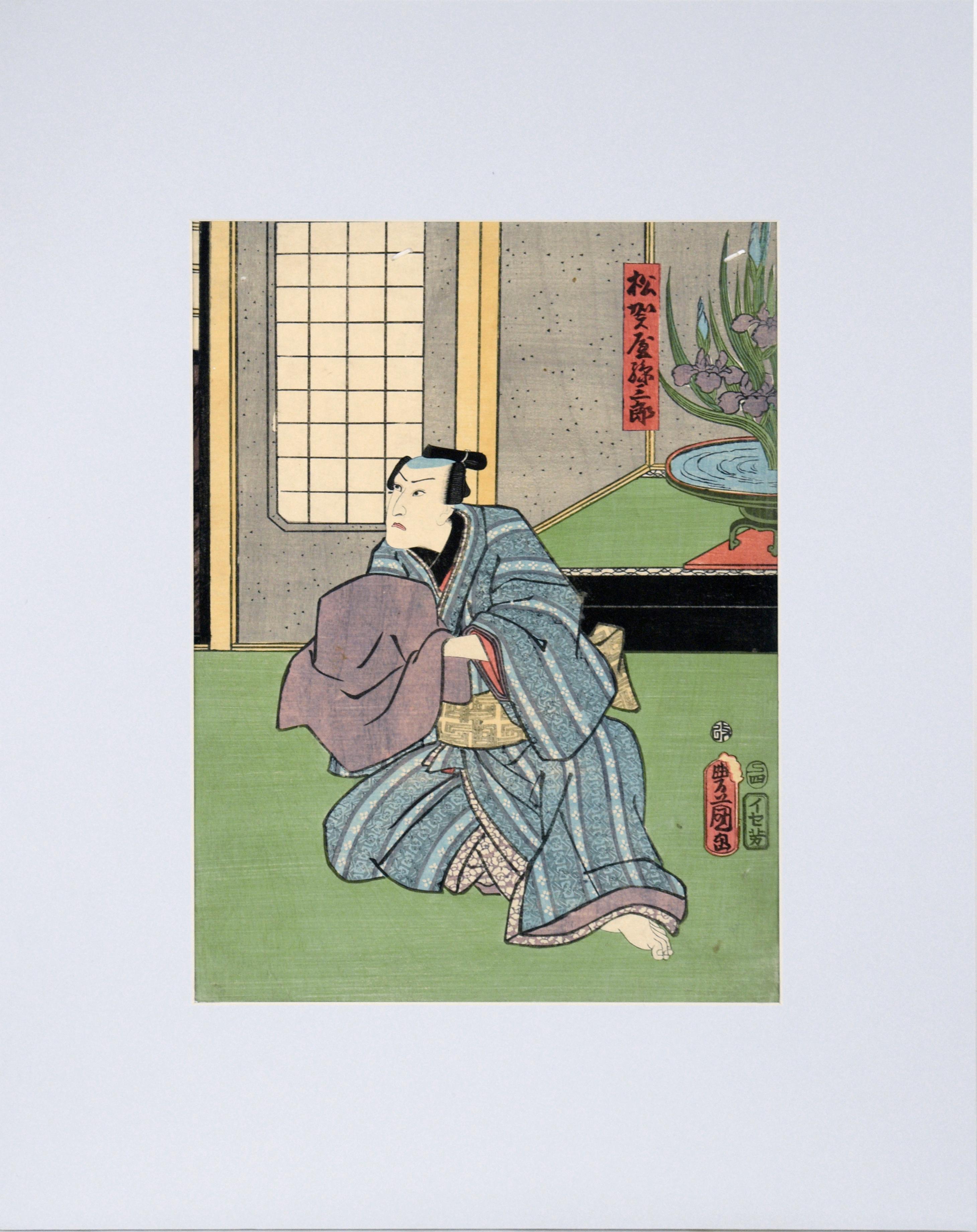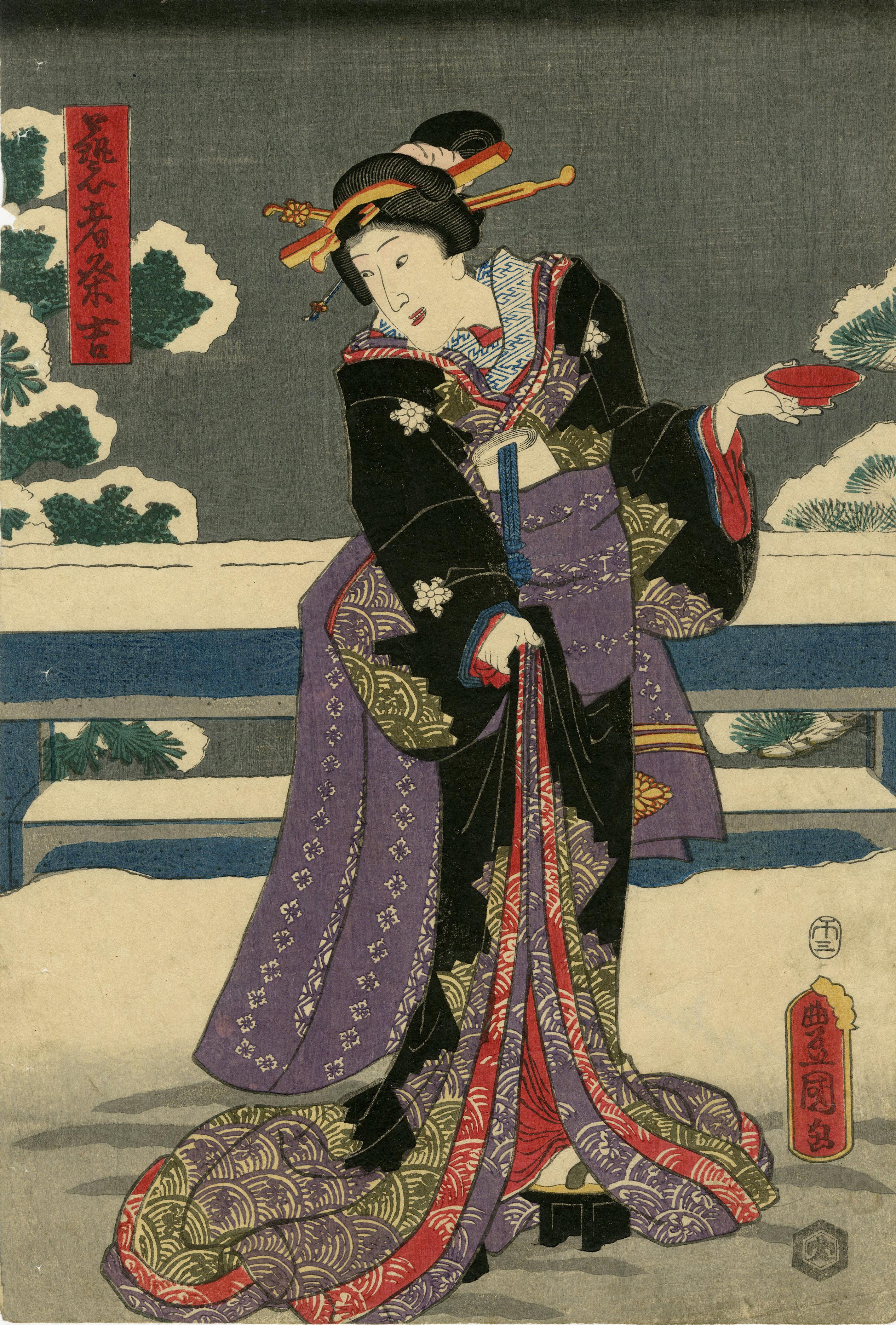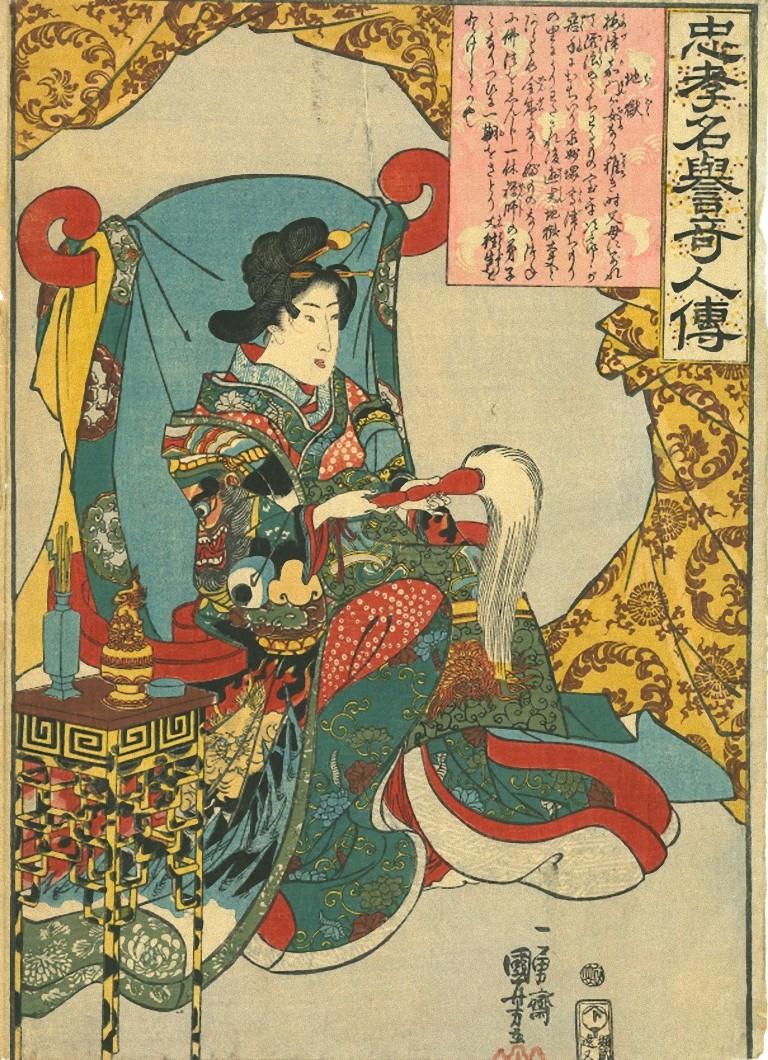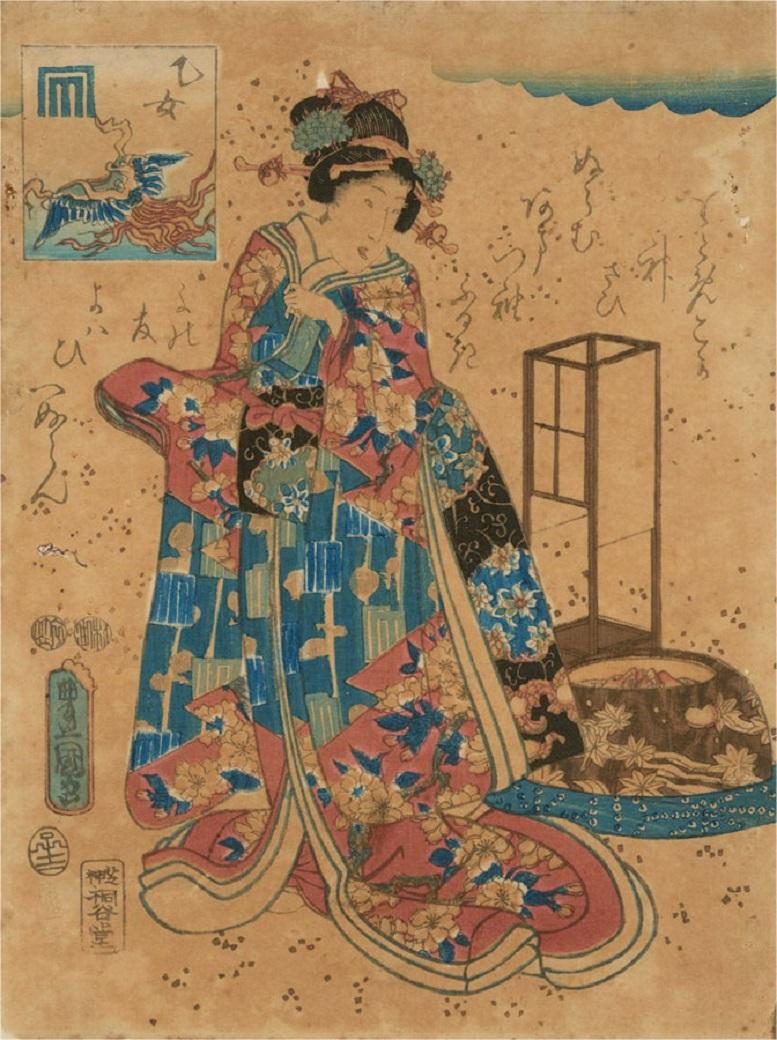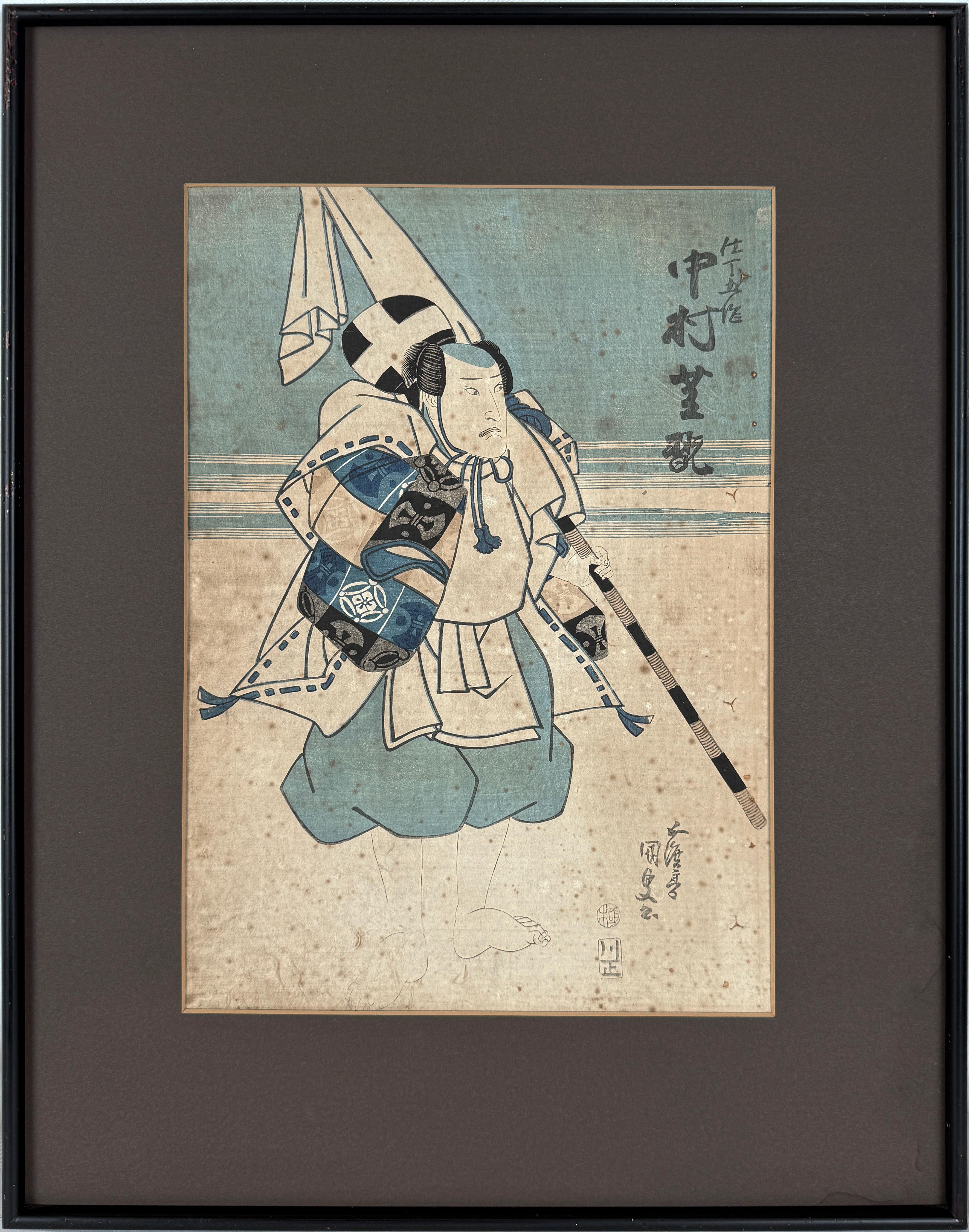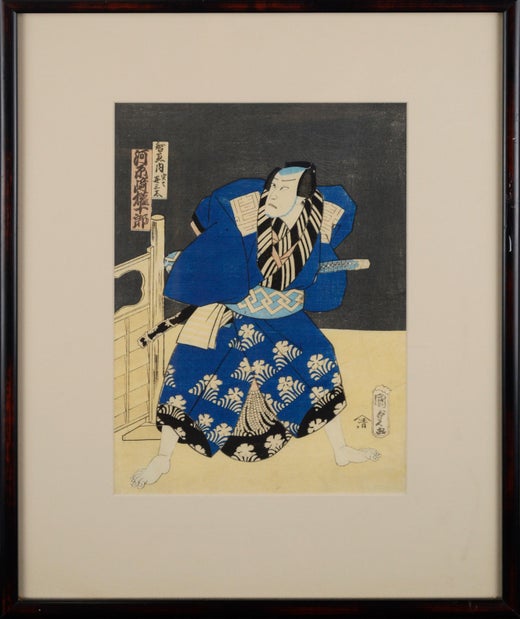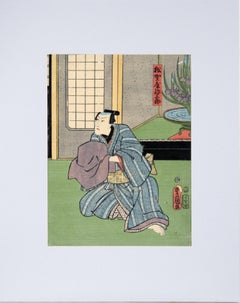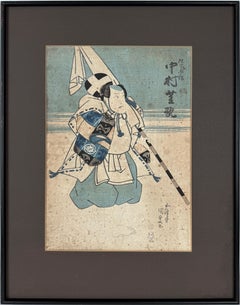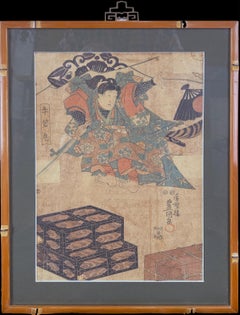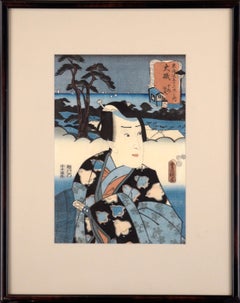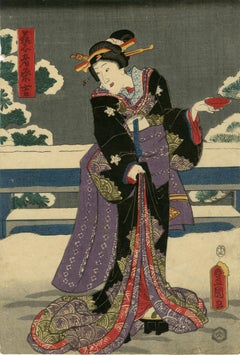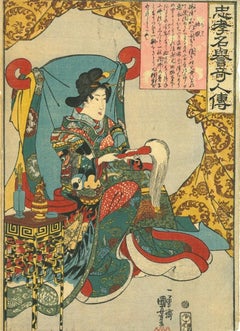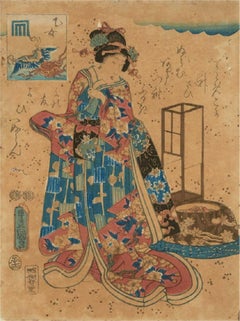Items Similar to The Courtesan Kashiwagi and the Kamuro Wakano - Japanese Woodblock Print
Want more images or videos?
Request additional images or videos from the seller
1 of 11
Utagawa Kunisada (Toyokuni III)The Courtesan Kashiwagi and the Kamuro Wakano - Japanese Woodblock Print1820-1830
1820-1830
$900
£687.22
€782.43
CA$1,263.74
A$1,381.52
CHF 730.88
MX$16,532.08
NOK 9,299.46
SEK 8,512.72
DKK 5,844.25
About the Item
The Courtesan Kashiwagi and the Kamuro Wakano - Japanese Woodblock Print
Original Toyokuni III/Kunisada (Japanese, 1786 - 1864) Japanese Woodblock Print
"The Courtesan Kashiwagi and the Kamuro Wakano and Chiyono from the Kadoebi House on Kyo Street," circa 1820 - 1830.
Wonderful portrait of the courtesan Kashiwagi of the Kadoebi House on Kyo Street, standing just outside the entrance gate of the establishment. She wears a fantastic black outer kimono patterned with a three-dimensional dragon, red flames, and swirling clouds. Her hair is arranged with tortoiseshell combs and hairpins decorated with flowers and spools of thread. Although her kamuro or child apprentices are mentioned by name in the text, they are not shown in the picture. A terrific Edo era beauty design.
Artist: Toyokuni III/Kunisada (1786 - 1864)
Presented in a new black mat.
Mat size: 19"H x 13"W
Paper size: 14.5"H x 10"W
Image size: 14"H x 9.5"W
Utagawa Hiroshige was born in 1797 in the Yayosu Quay section of the Yaesu area in Edo (modern Tokyo). He was of a samurai background, and was the great-grandson of Tanaka Tokuemon, who held a position of power under the Tsugaru clan in the northern province of Mutsu.
Not long after his parents' deaths, perhaps at around fourteen, Hiroshige—then named Tokutarō— began painting. He sought the tutelage of Toyokuni of the Utagawa school, but Toyokuni had too many pupils to make room for him. A librarian introduced him instead to Toyohiro of the same school. By 1812 Hiroshige was permitted to sign his works, which he did under the art name Hiroshige. He also studied the techniques of the well-established Kanō school, the nanga whose tradition began with the Chinese Southern School, and the realistic Shijō school, and likely the linear perspective techniques of Western art and uki-e.
Hiroshige's apprentice work included book illustrations and single-sheet ukiyo-e prints of female beauties and kabuki actors in the Utagawa style. It was not until 1829–1830 that Hiroshige began to produce the landscapes he has come to be known for, such as the Eight Views of Ōmi series. He also created an increasing number of bird and flower prints about this time. About 1831, his Ten Famous Places in the Eastern Capital appeared, and seem to bear the influence of Hokusai, whose popular landscape series Thirty-six Views of Mount Fuji had recently seen publication.
An invitation to join an official procession to Kyoto in 1832 gave Hiroshige the opportunity to travel along the Tōkaidō route that linked the two capitals. He sketched the scenery along the way, and when he returned to Edo he produced the series The Fifty-three Stations of the Tōkaidō, which contains some of his best-known prints. Hiroshige built on the series' success by following it with others, such as the Illustrated Places of Naniwa (1834), Famous Places of Kyoto (1835), another Eight Views of Ōmi (1834).
During his lifetime Kunisada Utagawa was considered to be the best print designer by his contemporaries. He was more popular than Hiroshige, Hokusai or Kuniyoshi. And Kunisada was extremely productive. His total output is estimated at more than 20,000 designs, many made by his students.
Kunisada was born near Edo (today Tokyo) as the son of an affluent merchant with a ferry boat license. At the age of fifteen he joined the famous art school of Utagawa Toyokuni and took the name Kunisada.
In 1807 the young artist produced his first illustrated book. And in 1808 his first actor prints were published. His fame grew fast. While other artists like Kuniyoshi Utagawa or Hiroshige had to fight for recognition for years, he was successful from the beginning.
He went on to become the most commercially successful of all woodblock printmakers ever. His early success may not have had a good influence on his personality. He had a reputation for his conceited personality.
Kunisada designed a wide spectrum of traditional ukiyo-e subjects like kabuki themes, beautiful women, historical events and quite a few shunga prints. He made few landscapes.
- Creator:Utagawa Kunisada (Toyokuni III) (1786-1864, Japanese)
- Creation Year:1820-1830
- Dimensions:Height: 19 in (48.26 cm)Width: 13 in (33.02 cm)Depth: 1 in (2.54 cm)
- Medium:
- Movement & Style:
- Period:
- Condition:Very good condition. Mat is new.
- Gallery Location:Soquel, CA
- Reference Number:Seller: N92031stDibs: LU54215967992
Utagawa Kunisada (Toyokuni III)
Born in the Honjo district of Edo as Kunisada Tsunoda, Kunisada’s family owned a small hereditary ferryboat service. Though his father, an amateur poet, died when Kunisada was a child, the family business provided some financial security. During his childhood, he showed considerable promise in painting and drawing. Due to strong familial ties with literary and theatrical circles, he spent time studying actor portraits. At age 14, he was admitted to study under Toyokuni, head of the Utagawa school. Kunisada's work embodies the characteristics of the Utagawa school, focusing on traditional subjects such as kabuki, bijin (beautiful women), shunga (erotic prints), and historical prints. His first known print dates to 1807, his first illustrated book to 1808. Kunisada’s career took off from the beginning. Many of his works became overnight successes and he was considered the “star attraction†of the Utagawa school. He signed his works “Kunisada,†sometimes with the studio names of Gototei and Kochoro affixed. In 1844, he adopted the name of his teacher and became Toyokuni III. Kunisada passed away in 1864 in the same neighborhood that he was born. He was 70 years old. Kunis
About the Seller
5.0
Platinum Seller
Premium sellers with a 4.7+ rating and 24-hour response times
Established in 1986
1stDibs seller since 2014
3,057 sales on 1stDibs
Typical response time: <1 hour
- ShippingRetrieving quote...Shipping from: Soquel, CA
- Return Policy
More From This Seller
View All"Sun Saburo Matsugaya" - Mid 19th Century Figurative Japanese Woodblock Print
By Utagawa Kunisada (Toyokuni III)
Located in Soquel, CA
"Sun Saburo Matsugaya" - Mid 19th Century Figurative Japanese Woodblock Print
Beautiful mid 19th century figural Japanese woodblock print of a seated man with lilies in the background by Utagawa Toyokuni III (Kunisada) (Japanese, 1786-1864/5). Artist's chop is in the lower right corner of the piece. The actor is Magosaburo Matsugaya from the play "Katakiuchi Rumors"
Presented in a new grey-blue mat with foamcore backing.
Mat size: 21"H x 16"W
Paper size: 14"H x 9.75"W
During his lifetime Kunisada Utagawa...
Category
1850s Edo Figurative Prints
Materials
Paper, Ink, Woodcut
Kabuki actor Nakamura Shikan II by Utagawa Kunisada Edo Japanese Woodblock Print
By Utagawa Kunisada (Toyokuni III)
Located in Soquel, CA
Kabuki actor Nakamura Shikan II by Utagawa Kunisada Japanese Woodblock Print
Wonderful portrait of Nakamura Shikan II, a prominent kabuki actor, in the role of Kisen Hoshi Toyokuni ...
Category
1820s Realist Figurative Prints
Materials
Printer's Ink, Rice Paper, Woodcut
Kumasaka Chōhan to Ushiwakamaru - One of a Diptych Original Woodcut Print
By Utagawa Kunisada (Toyokuni III)
Located in Soquel, CA
Kumasaka Chōhan to Ushiwakamaru is a Japanese Ukiyo-e print created between 1848 and 1854 by artist Utagawa Kunisada (Japanese, 1786-1864). The print is a Diptych, and is part of the...
Category
1850s Realist Figurative Prints
Materials
Printer's Ink, Rice Paper, Woodcut
"Juro Sukenari, Station #9: Oiso", Mid 19th Century Japanese Ukiyo-e Woodblock
By Utagawa Kunisada (Toyokuni III)
Located in Soquel, CA
Beautiful mid 19th century Japanese woodblock print of a samurai by Utagawa Toyokuni III (Kunisada) (Japanese, 1786-1864/5). This piece is from a series of "The 53 Stations of the To...
Category
1860s Edo Figurative Prints
Materials
Paper, Ink
Kabuki Actor, Mid 19th Century Figurative Japanese Woodblock Print
By Utagawa Kunisada (Toyokuni III)
Located in Soquel, CA
Beautiful mid 19th century figural Japanese woodblock print of a kabuki actor in blue by Utagawa Toyokuni III (Kunisada) (Japanese, 1786-1864/5). Artist's chop is in the upper left corner of the piece. Presented in a cream mat, with a black and red frame and plexiglas. Image size ~13.5"H x 9.5"W
During his lifetime Kunisada Utagawa...
Category
1860s Edo Figurative Prints
Materials
Paper, Ink
Annual Events for Young Murasaki (July) - Tales of Genji - Japanese Woodblock
By Utagawa Kunisada (Toyokuni III)
Located in Soquel, CA
Annual Events for Young Murasaki (July) - Tales of Genji - Japanese Woodblock
Rightmost panel a triptych, depicting monthly events for Wakamurasaki (Young Murasaki). This is the month of July. There appears to be a lesson taking place, possibly for writing or poetry.
Artist: Toyokuni III/Kunisada (1786 - 1864)
Publisher: Ebisu-ya Shoshichist
Presented in a new blue mat.
Mat size: 19"H x 13"W
Paper size: 14.5"H x 10"W
Commentary on the triptych:
In the Edo period, Tanabata was designated as one of the five seasonal festivals, and became an annual event for the imperial court, aristocrats, and samurai families, and gradually came to be celebrated by the general public. Its origins are said to be a combination of the Kikoden festival, which originated from the Chinese legend of Altair and the Weaver Girl, and Japan's ancient Tanabata women's faith. Ink is ground with dew that has accumulated on potato leaves, poems and wishes are written on five colored strips of paper, which are then hung on bamboo branches to celebrate the two stars that meet once a year. Although the illustration is a Genji painting...
Category
1850s Realist Figurative Prints
Materials
Printer's Ink, Rice Paper, Woodcut
You May Also Like
Courtesan Kumekichi
By Utagawa Kunisada (Toyokuni III)
Located in Fairlawn, OH
Courtesan Kumekichi
Color woodblock, 1858
Kabuki Actor Iwai Kumesaburo III in the role of courtesan Kumekichi, who is standing in snow hold a red sake cup
Publisher: Ohkuniya Kinjiro...
Category
1850s Other Art Style Figurative Prints
Materials
Woodcut
Oriental Woman - Woodcut by Utagawa Kunisada - 1830 ca.
By Utagawa Kunisada (Toyokuni III)
Located in Roma, IT
Oriental Woman is an original print realized around 1830 by Utagawa Kunisada.
Beautiful colored woodblock print.
Good conditions except for some folds...
Category
1830s Figurative Prints
Materials
Woodcut
Woman - Woodcut by Utagawa Kunisada - 1830 ca.
By Utagawa Kunisada (Toyokuni III)
Located in Roma, IT
Japanese Woman is a beautiful print realized around 1830 by Utagawa Kunisada.
Original colored woodblock print.
This wonderful modern artwork represents a portrait of a Japan woman...
Category
1830s Modern Figurative Prints
Materials
Woodcut
Utagawa Kunisada (1786-1865) - Woodblock, Portrait of a Japanese Lady
Located in Corsham, GB
This intricate woodblock print is a fine demonstration of Kunisada's later works. Depicting a beautiful lady dressing in floral kimono and decorative hair pieces. The signature to th...
Category
19th Century Portrait Prints
Materials
Woodcut
Yugiri - Woodcut by Utagawa Kunisada - 1850s
By Utagawa Kunisada (Toyokuni III)
Located in Roma, IT
Yugiri is an original artwork realized in the 1850s by Utagawa Kunisada (1786-1865).
Chapter 39 of the story Genji Monogatari. Color woodcut around 1851. Signed: Ichiyossai Toyokun...
Category
1850s Modern Figurative Prints
Materials
Woodcut
Bijinga - Woodcut by Utagawa Kunisada - 1844
By Utagawa Kunisada (Toyokuni III)
Located in Roma, IT
Bijinga is an original artwork realized in the half of the 19th Century by Utagawa Kunisada (1786-1865).
From the series "SHyakunin isshu esho" (Girl's pictures and 100 poets' card...
Category
1840s Modern Figurative Prints
Materials
Woodcut
More Ways To Browse
Japanese Woodblock Prints
Antique Invitations
Antique Spools
Hair Comb
Antique Hairpin
Antique Thread Spool
Tortoiseshell Comb
Warhol Flash
Western Etchings
Will Barnet Serigraph
Willis Wine Bar
Ww2 Propaganda Posters
Yoshitomo Nara Miss Spring
Yves Klein Blue Art
1959 Bullfight Picasso
727 Murakami
Ak47 Art
Alain Aslan
